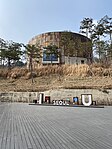Japanese School in Seoul
The Japanese School in Seoul (ソウル日本人学校, Souru Nihonjin Gakkō, 서울일본인학교) is a Japanese international school located in the Sangam-dong neighborhood of Mapo District, Seoul, for the children of Japanese citizens residing in South Korea.The Japanese School in Seoul was established on May 8, 1972, with a total of 33 kindergarten and primary school students. In 2005, it had grown to 403 students at kindergarten, primary and middle school levels. The Japanese School in Seoul is recognized by Japan's Ministry of Education as teaching a curriculum equivalent to schools for the same ages in Japan. The Japanese School in Seoul moved to its current location in Digital Media City (DMC) in Mapo on September 27, 2010, from its former location in the Gaepo-dong neighborhood of Gangnam District.
Excerpt from the Wikipedia article Japanese School in Seoul (License: CC BY-SA 3.0, Authors).Japanese School in Seoul
World Cup buk-ro 62-gil, Seoul
Geographical coordinates (GPS) Address Nearby Places Show on map
Geographical coordinates (GPS)
| Latitude | Longitude |
|---|---|
| N 37.5835898 ° | E 126.8842828 ° |
Address
서울일본인학교
World Cup buk-ro 62-gil
03923 Seoul
South Korea
Open on Google Maps







